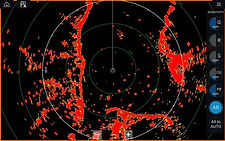
Cape Coral Marine Electronics
Cape Coral Marine Electronics



Frequently Asked
Frequently Asked
With all the rapid advances in marine electronic over the last few years, it's easy to feel confused. Below are some questions that we get asked all the time. If you have a question that is not answered here or if you want more information, feel free to contact Cape Coral Marine Electronics.


What is the difference between Traditional and CHIRP Sonar??
What is the difference between Traditional and CHIRP Sonar??
There are a few differences between traditional and CHIRP sonar, but the most important difference is "pattern matching". With a traditional sonar, the transducer sends a small ping of energy into the water at a single frequency, lets say 200khz. The ping travels down into the water, bounces off the bottom, travels back up to the transducer and the sonar system uses the time it takes for the ping to go full circle to calculate water depth. If there are ten fish below the boat, we get ten reflections coming back to the transducer. If the fish are really close to each other, those incoming reflections all come in on top of each other. Since all the signals are the same frequency (200khz in this example) you get one big overlapping signal at the transducer and one big blob on screen. In contrast, a CHIRP transducer signal changes frequency throughout the ping. It's almost like the transducer is sending out a little song. The song is a pattern that the sonar system recognizes, even when you get multiple overlapping returns. So if you have those same ten fish below the boat, the sonar can pick out ten return signals and show ten individual targets on screen, instead of one big blob. There are other differences like power output, frequency, cone angles and more between Traditional and CHIRP, but pattern matching is the key.
What is the difference between Traditional and High Definition Sonar?
What is the difference between Traditional and High Definition Sonar?
Several manufacturers have recently introduced new high definition sonar options with names like "ClearVu", "SideScan" and "Mega-imaging". So how are they different from Traditional sonar?? Well, all transducers work by converting an electrical pulse into an acoustic ping that is transmitted down through the water column. With traditional sonar, the ping is sent out in a circular pattern (360 degrees) that gets wider as it goes deeper.....picture a flashlight beam shining down into the water. One advantage of this shape is that it covers a large area of the water column all around the boat so you can see fish in all directions. One disadvantage of this shape is that it covers a large area of the water column all around the boat and all that information has to be crammed onto your display screen so you lose a lot of detail. In contrast, the new high definition transducers shape their sonar ping into a narrow beam of 1 or 2 degrees! The advantage is that all the sonar energy is focused on a very narrow slice of the water column so you get stunning detail and clarity. The disadvantage is that all that sonar energy is focused on a very narrow slice of the water column so if you are not right on top of a target, you will miss it. Many transducers are capable of pinging in both Traditional as well as Hi-Def, so you can get the best of both worlds in a single transducer. We can help you choose the right transducer for your boating style.



What is the difference between Domed Radar and Open Array?
What is the difference between Domed Radar and Open Array?
- A narrower radar beam gives you get better target separation. If two boats are anchored close to each other a domed radar might show them on screen as one big blob where an open array would see them as individual targets.
- A narrower radar beam puts more energy on every target. If you have a 4Kw (4000 watt) domed radar, that energy is spread over its 5 degree HBW. But a 4Kw open array can focus all that energy down to say 2 degrees. You will get more energy on every target and have a better chance to see targets farther away.
- A narrower radar beam can mean the difference between seeing a small target and not. I'll put it this way, if you want to use radar to spot birds working the surface like diving on a bait ball, then you have to get an open array.
So; although every radar should do a decent job of showing hard targets like land mass, channel markers and boats, open arrays will do a better job of finding marginal radar targets like birds, small buoys etc. If you are using radar only occasionally, primarily for collision avoidance, or you have a smaller boat with no room to swing a large 4-6ft antenna then a radar dome is for you. If you use radar all the time, or you need to see the smallest of targets using radar, or you just want to have that big ol' helicopter blade spinning around up there cause it looks cool, then an open array radar is for you.